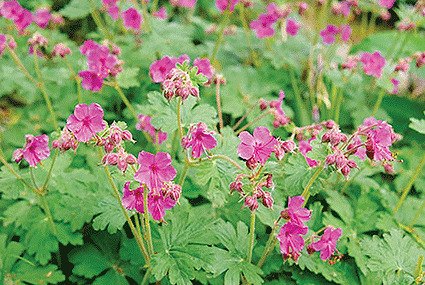Gardening Journal: Plant of The Month – Geranium macrorrhizum
February 1st, 2021 By the end of the month, we hope for warmer weather and with that more opportunities to get out and about and enjoy mother nature as she awakens from her winter hibernation.
By the end of the month, we hope for warmer weather and with that more opportunities to get out and about and enjoy mother nature as she awakens from her winter hibernation.While February can often be cold and wet it can also be bright and cheery too. Spring is almost with us and there are plants that start to send up flowers that lift our spirits as the days lengthen and we feel the winter receding behind us. By the end of the month, we hope for warmer weather and with that more opportunities to get out and about and enjoy mother nature as she awakens from her winter hibernation.
Most people will be familiar with Geranium macrorrhizum, and while it may not always be remembered fondly, it is easy to grow, doesn’t mind where it grows, and is now a plant I wouldn’t be without. It is an aromatic perennial with attractive soft leaves and pink or purplish flowers sitting on mounded clumps of light green, semi evergreen foliage.
Geranium is a genus of 422 species of flowering plants found throughout the temperate regions of the world and the mountains of the tropics. They come in a variety of shapes and sizes and the five-petaled-flowers can be white, pink, purple or blue, often with distinctive veining. The genus name is derived from the Greek géranos meaning ‘crane’. The common name is ‘cranesbill’.
Geranium macrorrhizum is native to Europe where it is found in the southern Alps, Apennines, Balkan Peninsula and Carpathians. In Bulgaria, G. macrorrhizum is widely grown as a cultural symbol associated with health and good luck. It is also the source of Zdravetz oil, which is used in traditional medicine as both a stimulant and as a carminative. The essential oils found in both the aerial parts and rhizomes have also been shown to have antibacterial activity. On its own,big-root geranium, as it is commonly known, is completely underwhelming. Sitting in a nursery container it looks like a geranium that is not doing much of anything. But there is a warrior hiding under that somewhat ordinary exterior and it has long been recognized as one of the most durable and easy to grow perennials for the garden.
I use this geranium for those difficult dry, shady areas under trees and shrubs where nothing else will grow. They provide a mounded carpet of foliage that requires little attention and can be combined with other herbaceous plants to provide combinations of texture and colour that will make the dreariest corner of the garden look great again. Try combining with Hachenochloa macra aureolea, Dryopteris wallichiana, Helleborus orinentalis, Brunnera Jack Frost and Liriope muscurii - A tried and tested combination that will light up any shady corner!
Geranium macrorrizhum is happy growing in sun or shade and will also grow in any soil that is not waterlogged. It is completely untouched by deer and rabbits and does not require much, if any, maintenance at all. Once established this plant will provide the gardener with little trouble. While it is not “flashy” by any means, it does “its thing” well and should be considered more often for those difficult shady corners of the garden where nothing else will grow.
Jobs to be done in February:
Ornamental Garden
• In late February cut back hard (coppice) all the Cornus (Dogwood) to low buds.
• If snow falls – do not let the snow sit on the shrubs, gently shake off to prevent damage.
• Prune Roses creating an open outward facing framework.
• Prune Clematis (late/summer flowering)
• Shape borders to neaten edges.
• In late February – cutback deciduous grasses
• Remove weeds from borders as necessary.
• Prune out dead; diseased or damaged wood from trees and shrubs.
• Complete pruning of Apple/fruit trees if not already done.
• Mulch borders if not already done in Autumn – taking care of emerging bulbs.
• Cut back Hydrangea Preziosa to first healthy buds on stems.
• Cut back Hydrangea Annabelle to a half/third to retain a compact shape.
• Cut back side shoots of wisteria, pruning to two to three buds.
• Plant new climbers such as clematis/honeysuckle
• Prune summer flowering deciduous shrubs that flower on the current years growth – eg Buddleja, lavatera etc.
• Sow hardy annuals for summer colour.
Vegetable Garden:
• Buy seed potatoes and chit tubers by placing them eye end up in trays or egg boxes in a light, cool, frost free place.
• Sow crops like broad beans, lettuce etc and place in greenhouses or coldframes for an earlier harvest.
• Now’s the time if you want to think about planting asparagus – keep weed free and mulch with a thick layer of organic matter.
• Apply general fertiliser like growmore/blood fish and bone to beds.
• Mulch tree and cane fruit after pruning.
• Plant garlic.
• Spray dormant fruit bushes with a plant oil based winter wash to kill overwintering eggs or aphid pests.
Most people will be familiar with Geranium macrorrhizum, and while it may not always be remembered fondly, it is easy to grow, doesn’t mind where it grows, and is now a plant I wouldn’t be without. It is an aromatic perennial with attractive soft leaves and pink or purplish flowers sitting on mounded clumps of light green, semi evergreen foliage.
Geranium is a genus of 422 species of flowering plants found throughout the temperate regions of the world and the mountains of the tropics. They come in a variety of shapes and sizes and the five-petaled-flowers can be white, pink, purple or blue, often with distinctive veining. The genus name is derived from the Greek géranos meaning ‘crane’. The common name is ‘cranesbill’.
Geranium macrorrhizum is native to Europe where it is found in the southern Alps, Apennines, Balkan Peninsula and Carpathians. In Bulgaria, G. macrorrhizum is widely grown as a cultural symbol associated with health and good luck. It is also the source of Zdravetz oil, which is used in traditional medicine as both a stimulant and as a carminative. The essential oils found in both the aerial parts and rhizomes have also been shown to have antibacterial activity. On its own,big-root geranium, as it is commonly known, is completely underwhelming. Sitting in a nursery container it looks like a geranium that is not doing much of anything. But there is a warrior hiding under that somewhat ordinary exterior and it has long been recognized as one of the most durable and easy to grow perennials for the garden.
I use this geranium for those difficult dry, shady areas under trees and shrubs where nothing else will grow. They provide a mounded carpet of foliage that requires little attention and can be combined with other herbaceous plants to provide combinations of texture and colour that will make the dreariest corner of the garden look great again. Try combining with Hachenochloa macra aureolea, Dryopteris wallichiana, Helleborus orinentalis, Brunnera Jack Frost and Liriope muscurii - A tried and tested combination that will light up any shady corner!
Geranium macrorrizhum is happy growing in sun or shade and will also grow in any soil that is not waterlogged. It is completely untouched by deer and rabbits and does not require much, if any, maintenance at all. Once established this plant will provide the gardener with little trouble. While it is not “flashy” by any means, it does “its thing” well and should be considered more often for those difficult shady corners of the garden where nothing else will grow.
Jobs to be done in February:
Ornamental Garden
• In late February cut back hard (coppice) all the Cornus (Dogwood) to low buds.
• If snow falls – do not let the snow sit on the shrubs, gently shake off to prevent damage.
• Prune Roses creating an open outward facing framework.
• Prune Clematis (late/summer flowering)
• Shape borders to neaten edges.
• In late February – cutback deciduous grasses
• Remove weeds from borders as necessary.
• Prune out dead; diseased or damaged wood from trees and shrubs.
• Complete pruning of Apple/fruit trees if not already done.
• Mulch borders if not already done in Autumn – taking care of emerging bulbs.
• Cut back Hydrangea Preziosa to first healthy buds on stems.
• Cut back Hydrangea Annabelle to a half/third to retain a compact shape.
• Cut back side shoots of wisteria, pruning to two to three buds.
• Plant new climbers such as clematis/honeysuckle
• Prune summer flowering deciduous shrubs that flower on the current years growth – eg Buddleja, lavatera etc.
• Sow hardy annuals for summer colour.
Vegetable Garden:
• Buy seed potatoes and chit tubers by placing them eye end up in trays or egg boxes in a light, cool, frost free place.
• Sow crops like broad beans, lettuce etc and place in greenhouses or coldframes for an earlier harvest.
• Now’s the time if you want to think about planting asparagus – keep weed free and mulch with a thick layer of organic matter.
• Apply general fertiliser like growmore/blood fish and bone to beds.
• Mulch tree and cane fruit after pruning.
• Plant garlic.
• Spray dormant fruit bushes with a plant oil based winter wash to kill overwintering eggs or aphid pests.
Comments (0)
No comments have been submitted yet.Why not be the first to send us your thoughts
Leave A Comment
Thank you for your comments, they will appear shortly once approved.
Recent Posts
Have You Seen...






